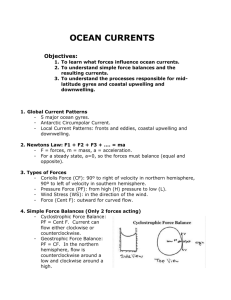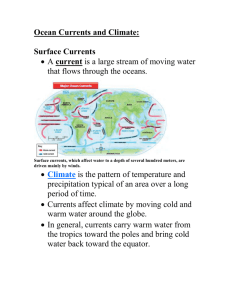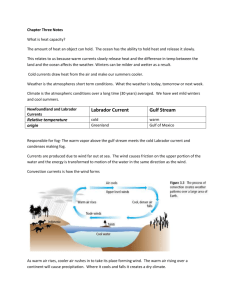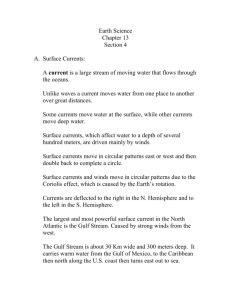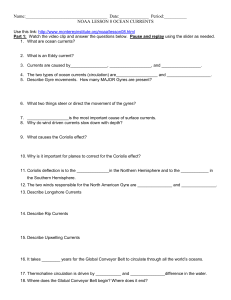Ocean Circulation
advertisement
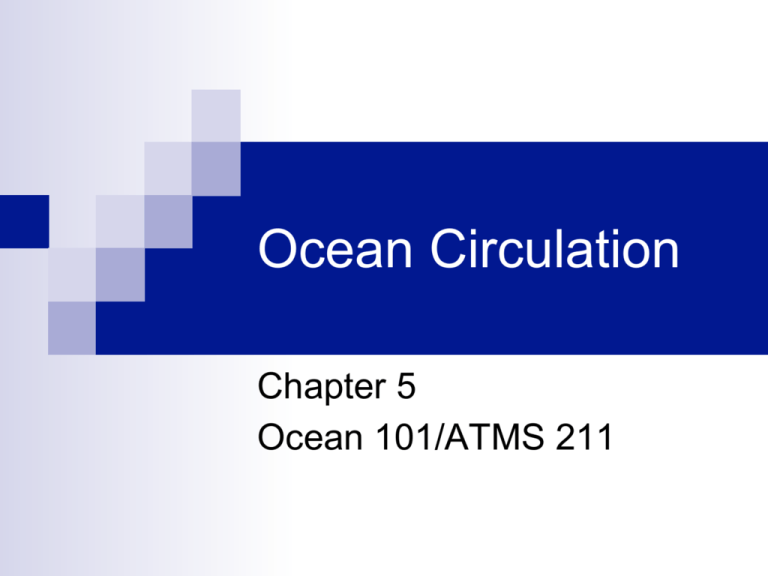
Ocean Circulation Chapter 5 Ocean 101/ATMS 211 Surface Winds Recap n Trade winds converge at the equator n Winds are named by the direction they are coming FROM Wind-Driven Surface Currents n n Wind movement causes friction, dragging top 50-100 m of seawater Coriolis deflects water about 25° to the right of wind direction (in northern hemisphere) Wat er dire ct ion Wind direction Atlantic Gyres n n Note circular motion of ocean currents in both hemispheres Can you see the Coriolis Effect in action? North Atlantic Gyre n Divided into four interconnected currents: • • • • Gulf Stream North Atlantic Current Canary Current North equatorial Current Sea Surface Height 2 meters higher on western side of Atlantic n Colors represent sea surface heights What Causes the Bulge? n Westerly Winds n Trade Winds In theory, water is transported to the RIGHT of the wind direction in the northern hemisphere. But why?? Ekman Spiral n Topmost layer of water flows at 45° to the right of wind direction due to Coriolis Effect in northern hemisphere Ekman Spiral n n n Next layer down doesn’t “feel” the wind, it “feels” the motion of the layer above it Motion of this layer is 45° to the right of the layer above This continues to about 100 m depth Ekman Transport n n Due to friction, each layer moves more slowly than layer above, and 45° to the right of the layer above Note that at some depth, water is flowing opposite to direction of surface current Ekman Transport n n In theory, the net effect of Ekman transport is that water is transported 90° to the right of wind direction In reality, angle is less than 90° Geostrophic Currents n n Water flows down the hill due to gravity, then turns to the RIGHT in northern hemisphere Gravity/pressure gradient & Coriolis force are in balance The Bottom Line n The interaction between these forces keep ocean currents flowing in gyres: ¨ Wind energy ¨ Coriolis Effect ¨ Gravity (downhill pressure gradient) ¨ Friction between water molecules Surface Currents SST View of Geostrophic Gyres Surface currents carry warm water away from the equator and cold water away from the poles Western Boundary Currents n n Warm, fast-moving, narrow and deep Gulf Stream, Kuroshio, Brazil ,Agulhas, E. Australia Westward Intensification n Water piles up on the western side of ocean basins due to Earth’s rotation and trade winds n Piled up water “pushes” western boundary currents along the continent towards the poles n Result: Gulf Stream moves at 5 miles/hr to depth of 1500 ft. Gulf Stream Schematic Text Gulf animation Warm & Cold Core Eddies n Meanders become cold and warm core eddies Gulf Stream from Space n Warm Core Eddy n n Meander Cold Core Eddy Gulf Stream moves north along east coast Moves offshore near Cape Hatteras, NC and starts to meander Cold core and warm core eddies form when meanders pinch off Eastern Boundary Currents n Cold, weak, broad, shallow currents n Canary, Benguela, Peru, California Equatorial Currents & Countercurrents n n Equatorial currents driven west by the trade winds Countercurrents caused by backflow of water along the equator West Wind Drift n n West Wind Drift travels around the Earth without interruption Very useful for round the world sailing but BEWARE of extratropical cyclones and rogue waves! Upwelling, Downwelling & El Niño Upwelling n n n Found in areas of surface divergence Brings nutrient-rich, cold water up to the surface to replace surface water Associated with areas of high biological productivity Where Does Upwelling Occur? Equatorial upwelling Coastal upwelling Why Does Equatorial Upwelling Occur? n Divergence of currents at equator due to Coriolis Effect & Ekman transport produces upwelling Coastal Upwelling n In northern hemisphere, wind blowing from north causes Ekman transport to the west Upwelling & Primary Productivity n n Upwelling off US west coast brings up cold, nutrient-rich water Image shows high amounts of phytoplankton due to coastal upwelling Downwelling n n n Found in areas of surface convergence Downward movement of nutrient-poor, warm surface water Associated with areas of low biological productivity Downwelling n Wind from the south leads to Ekman transport of surface water towards shore in northern hemisphere Let’s Practice! Upwelling or Downwelling? Equator Wind Upwelling Upwelling or Downwelling? Upwelling Wind Downwelling Equator Upwelling or Downwelling? Equator Wind Downwelling Upwelling or Downwelling? Upwelling Wind Equator Normal Tropical Pacific Circulation Normal SST Note upwelling of cold water off the coast of South America Normal Ocean Cross Section Note upwelling of cold water off the coast of South America El Niño (ENSO) El Niño, SST Note warm water off the coast of South America El Niño (ENSO) Note warm water off the coast of South America Which is ENSO SST Map? A B El Niño (ENSO) Events n FIRST, trade winds weaken near equator n SECOND, equatorial currents grind to a halt n THIRD, warm water flows backwards towards South America n FOURTH, coastal upwelling system shuts down as warm water blocks Peru Current El Niño Effects n n n n Warm, dry winters in Pacific Northwest Drought and fires in Australia, Indonesia Heavy rains along western South America coast Fisheries in Peru collapse A Pacific Event, Felt Worldwide El Niño Frequency 82-83 2009-2010 97-98 Are ENSO events happening more frequently? Thermohaline Circulation Could This Really Happen?? Vertical Stratification n Stratification is the vertical density layering of the water column ¨ Waters of different densities are found at different depths ¨ Less dense water floats on top of more dense water ¨ Warmer water floats & cooler water sinks ¨ Fresher water floats & saltier water sinks Example: Thermal Stability n Lake Washington ¨ Surface warms in summer ¨ Warm (lower-density) water lies on top of cool (higherdensity) water ¨ Thermocline: boundary to mixing between layers of different temperatures Temperature à Instability & Overturning n IF the water column becomes unstable… ¨ More dense water on top of less dense ¨ Dense water sinks, less dense water rises Thermohaline Circulation: Density Driven Currents n Water moves vertically due to density differences n Changes in temperature and salinity in surface water can cause water to sink What Causes Instability? n Anything That Increases Surface Density or Decreases Deep Water Density ¨ Surface Cooling ¨ Sea Ice Formation ¨ Surface Evaporation ¨ Sea-floor Heating at Hydrothermal Vents Instability in Polar Oceans n Rapid Cooling in Winter ¨ Dense, cold water at the surface sinks below warmer water beneath ¨ Major factor in global density-driven ocean currents n Sea Ice Formation in Winter ¨ Sea ice freezing à excludes salt ¨ Salt remains in sea water, raising salinity & density ¨ Salty water sinks below less-salty water beneath In A Test Tube Ocean… Fresh water ice Salty, slushy and dense Where Is Deep Water Forming? North Atlantic, near Greenland Around Antarctica Mediterranean Geography… Mediterranean Sea Evaporation in desert climate creates highsalinity, high density surface layer n Very little fresh water inflow from rivers n High salinity water sinks n Evaporation of Fresh Water Surface water getting saltier Water sinks until it finds its density level Cross Section View… German U-boat Global Thermohaline Circulation Ocean Circulation & Climate n The ocean stores and releases huge quantities of heat n Bottom water is a CO2 holding tank… until it returns to the surface every 1000 years or so Climate Change and Thermohaline Circulation Increased rain at the poles could dilute surface water, preventing sinking n Melting ice dilutes water, preventing sinking n Warming surface water is not dense enough to sink n It’s possible that increasing temperatures could shut down the global conveyor system…there are signs in the North Atlantic that it’s already starting n

